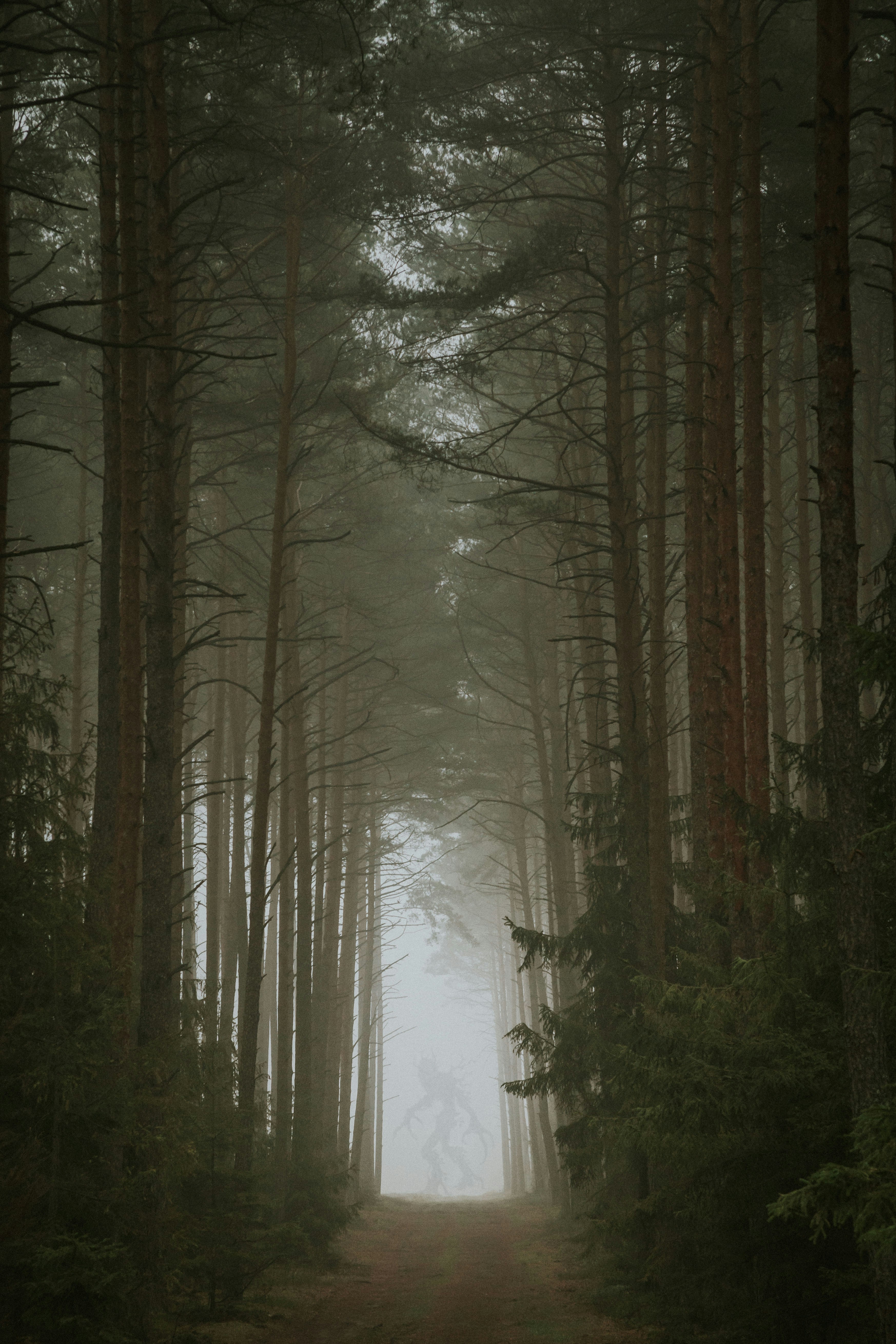
How to beat Goliath
Because size doesn’t matter
I have formulated 6 rules which I call David’s rules. These are for anyone facing the big one ...
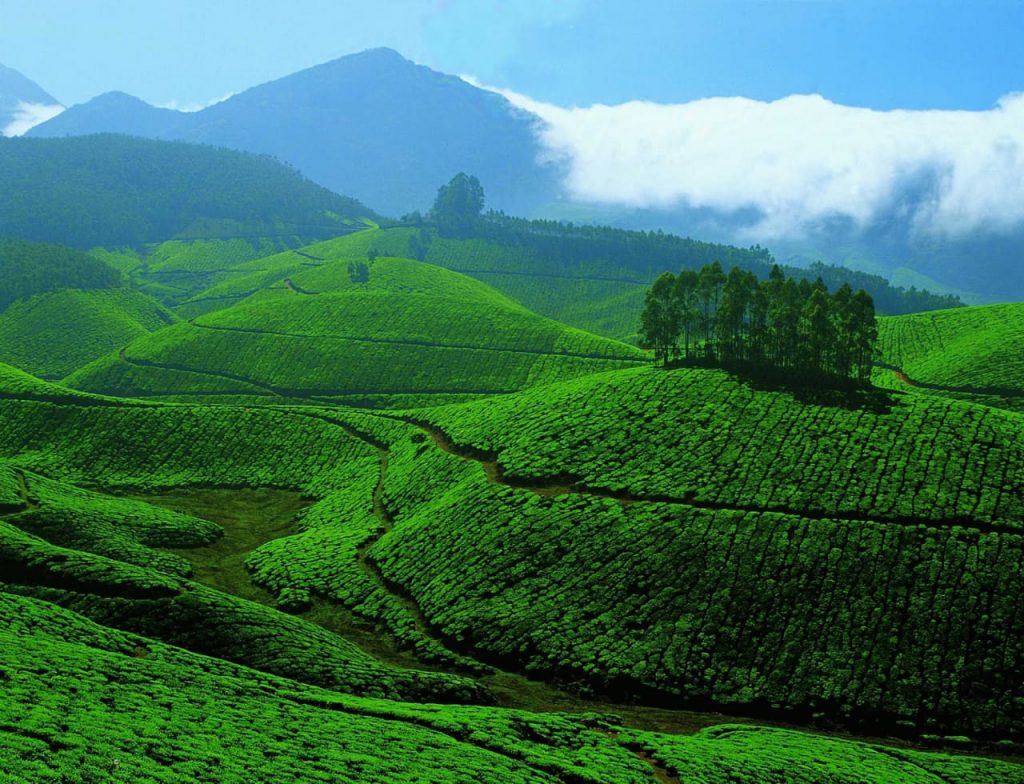
Each new day was a joy in the tea gardens. The British planters who built the bungalows had a keen eye for detail and perspective. They built the bungalows on hilltops or ridges where they had the most spectacular views. Anamallais is one of the most beautiful places on earth and finding suitable places to build the bungalows was not difficult.
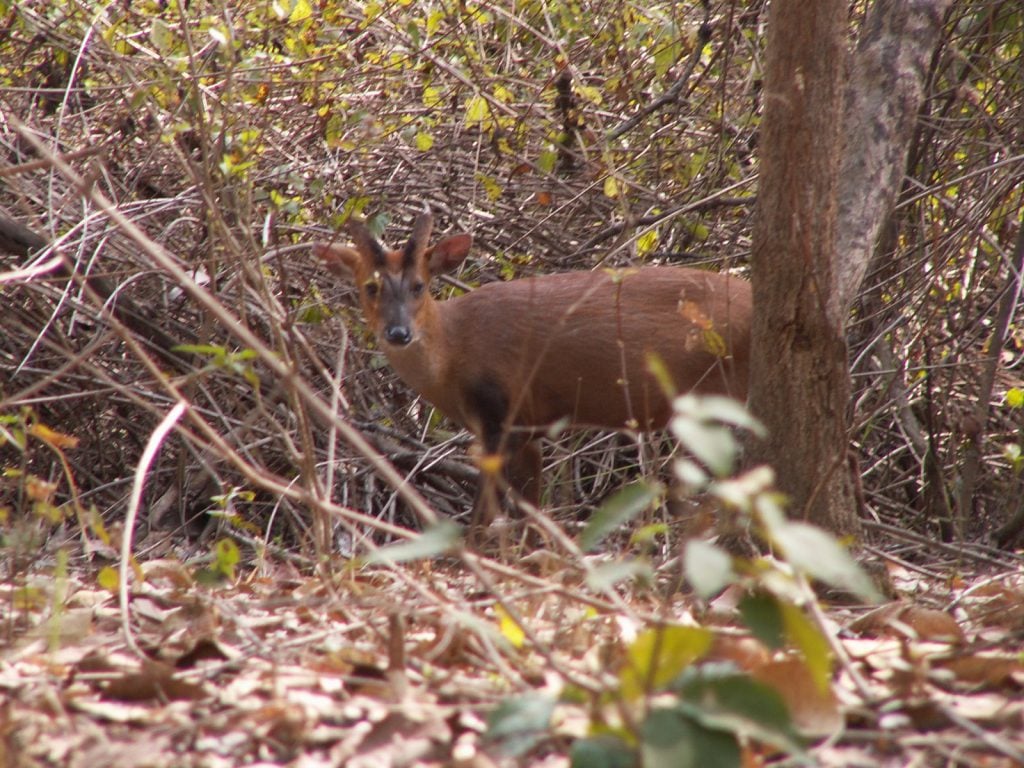
Except in rainy weather, it was my custom to have my first cup of tea on the veranda of the bungalow, in most cases watching the sun coming up. How can I describe the joy of that? Most mornings in Lower Sheikalmudi, I would have my tea watching a Barking Deer grazing on the lawn. This was a particularly brave buck who had realized that I would never harm him and so did not run away when the door opened, and I came out. He would look up and go back to his feeding once he saw who it was. It was in this bungalow that there was a Champa tree just outside the veranda on which my naturalist friend Hashim Tyabji counted sixty different bird species. The variety of bird life in the Anamallais is amazing. People like me kept bird books and shared sightings. One day I got a message from the Estate Office to say Mr. Rawlley, my General Manager, wanted to speak to me. Even though he was a wonderful man and a dear friend, it is never very comfortable to receive a call that says the Big Boss wants to talk to you. You naturally ask yourself, ‘Now what did I do?’ Well, there was no escape and so I went to the office and called him. He said to me, ‘Yawar, have you ever seen a Rufus Bellied Hawk Eagle?’
I said, ‘I know what it looks like Mr. Rawlley, but I don’t recall seeing it here.’
‘Will you keep an eye open for it and call me if you do spot one? I was reading that their range includes the Anamallais and I would be very interested to see one.’
Wildlife and jungles were our major interest in planting and one of the major reasons why we stuck in a job which was hard, under paid, and underappreciated in the outside world.
I remember one early Sunday morning, while it was still misty, Hashim and I were walking along a forest path down near the Parambikulam River dam. At one place where a forest giant had fallen the sun was shining through and there was a leafy tree with some type of berry on it. On this tree were a multitude of birds, all apparently flying around randomly and eating the berries. Hashim stopped me silently with a hand signal and we sat down on our haunches to watch the birds. Hashim showed me how different species of birds were eating from different levels in the tree. An amazing insight into the highly ordered life of birds. ‘Free as a bird’ is a figment of human imagination. Birds are so tied-in to their life structures that some bird species have been known to die out in a particular area because a particular tree on which they were dependent for food or nesting was cut down. The importance of habitat conservation in preserving avian and animal species can hardly be overemphasized. We sat there for a while and then went along our way to the place where we intended to catch some fish.
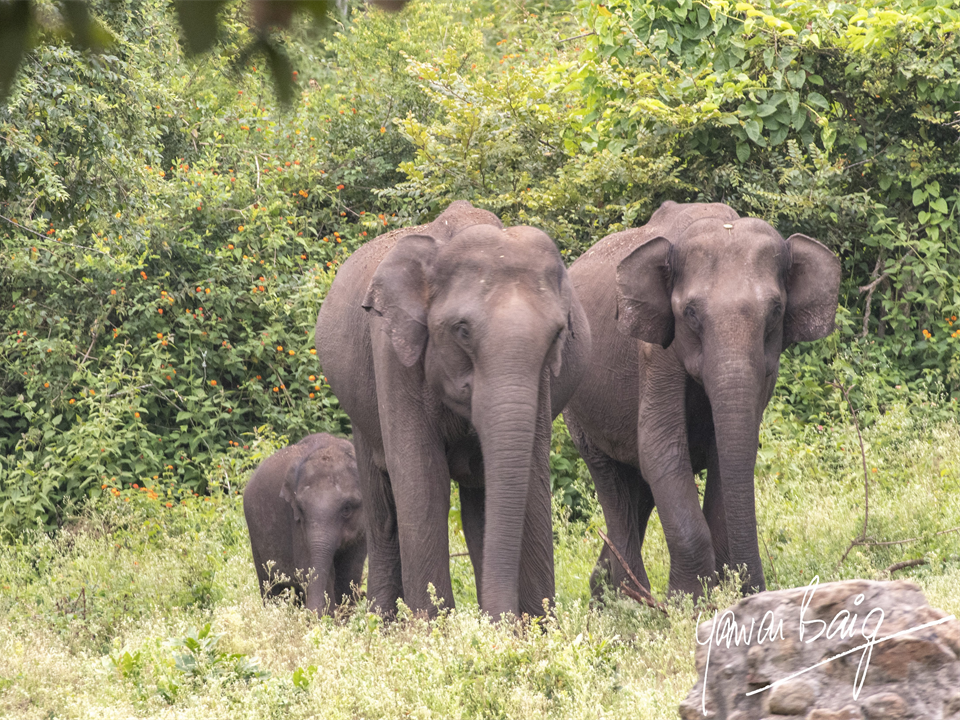
As we walked along the forest, we smelt them long before we saw them and Hashim and I stepped down from the road and walked a few feet into the forest and stood behind some big trees. And lo and behold came along the road a whole herd of elephants. Gliding soundlessly on huge feet that they put more delicately on the ground than would a ballet dancer. All going to the river for their morning drink and bath. How can I describe the sense of excitement? The elephants knew we were there of course. But they knew that we meant no harm and so they went their way. The so-called Law of the Jungle is that if you give respect, you get respect. It is our civilized society that lives by a different rule. The payment for this chance to see this elephant life was the leeches that we had to pull off ourselves once we came back onto the road after the herd had passed. But that was hardly something to complain about for the privilege of being a part of life that has gone on for millennia before us and now seems in grave danger of ending forever.
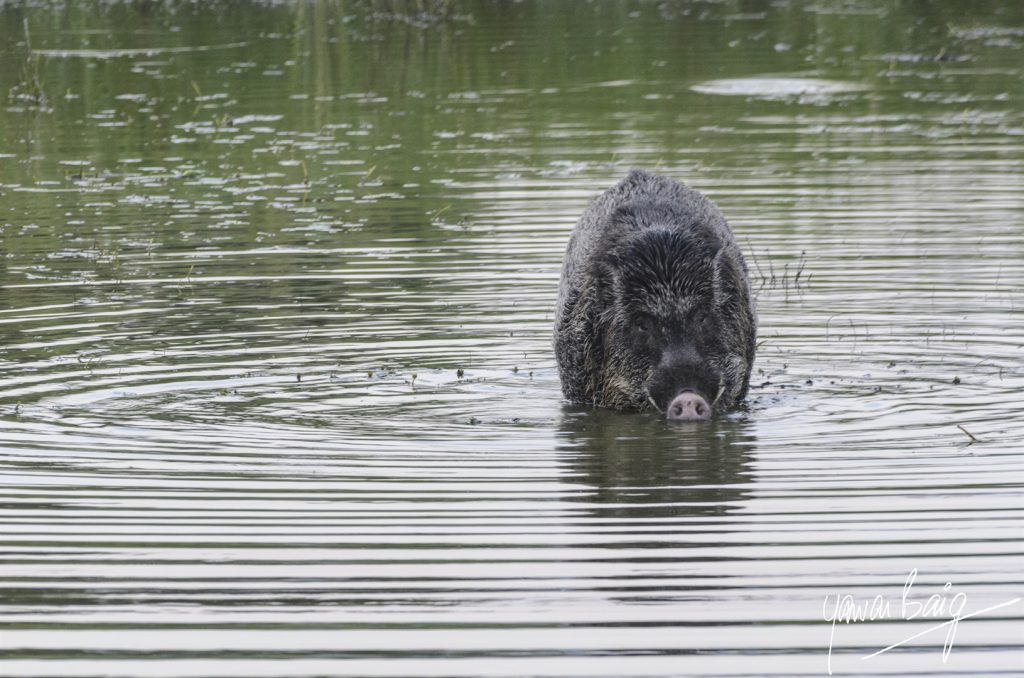
The tea in the Anamallais is so surrounded by forest that even when I walked along a path in the tea field, I would often see various animals. The most common sight were Barking Deer and Wild Boar usually in the valleys between the hills on which tea was planted. The tea bush is about three and a half feet in height and as it is planted very densely with more than fifteen thousand to the hectare, it creates a complete micro-environment of its own. Below it is thick shade, almost no undergrowth, and clear pathways to anywhere that any animal the size of a large dog wants to go. So, this becomes the preferred habitat for Barking Deer, Wild Boar, Dhole (Wild Dog), Jungle Fowl, and all kinds of snakes. However, to eat they must come out from under the tea because the tea itself is not edible. In the early mornings, Barking Deer come out to graze in the hollows and valleys and in the small rocky clearings in the middle of the tea. In late evenings and night, it is the turn of the Wild Boar, which are more nocturnal in nature. They come out mainly in the swamps where the earth is soft and root around for grubs, tubers, and roots of the plants that grow in these valleys. Jungle Cocks (Grey Jungle Fowl) herald the sunrise and you can hear them crowing all over the hillsides as the sun comes up. Kuk-koo-koo-Kuk – one Jungle Cock would call and be answered by his rival from over another hill. They are belligerent birds, territorial, and ever ready to defend their harem. Their womenfolk quietly scratch around for the early worms. Is getting up early a good habit? Depends on whether you are a bird or a worm.
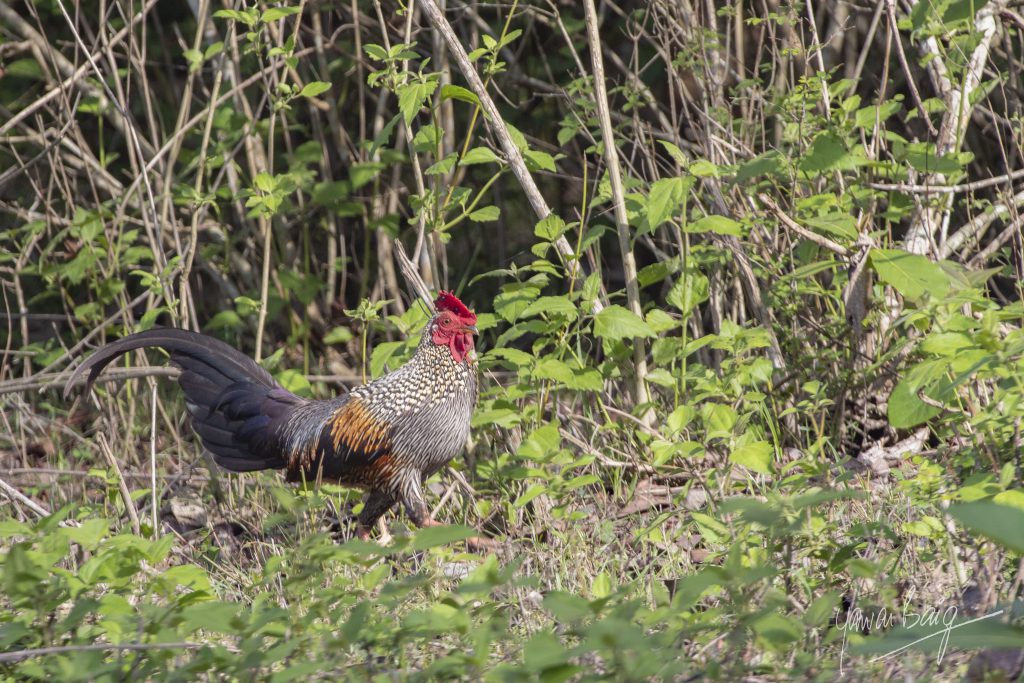
Sometimes there are unexpected encounters with animals in the tea fields. Some are funny, but others are not. The most common is when a line of workers is scattering fertilizer and they unknowingly scare a sounder of Wild Boar which has been lying up in the day. The pigs tend to stampede away from the men and whatever comes in their way, they run over it. At a time like this the only thing to do if you can, is to find a rock and jump on top of it and watch the pigs run on either side. Getting in the way of stampeding wild boar is a good way to die quickly in a nasty way. The key of course is to find a convenient rock. If you don’t then you stand to encounter a wild boar rather more directly than you would want to. The results are unpredictable. One of my plucking workers got a pig stuck in her plucking skirt and rode on his back for a ways before she got thrown off. Luckily, apart from some bruises she lived to tell the tale. Another was not so lucky because the boar gored her with his tusks, and she was badly torn up. She also survived but had to have a long and painful convalescence.
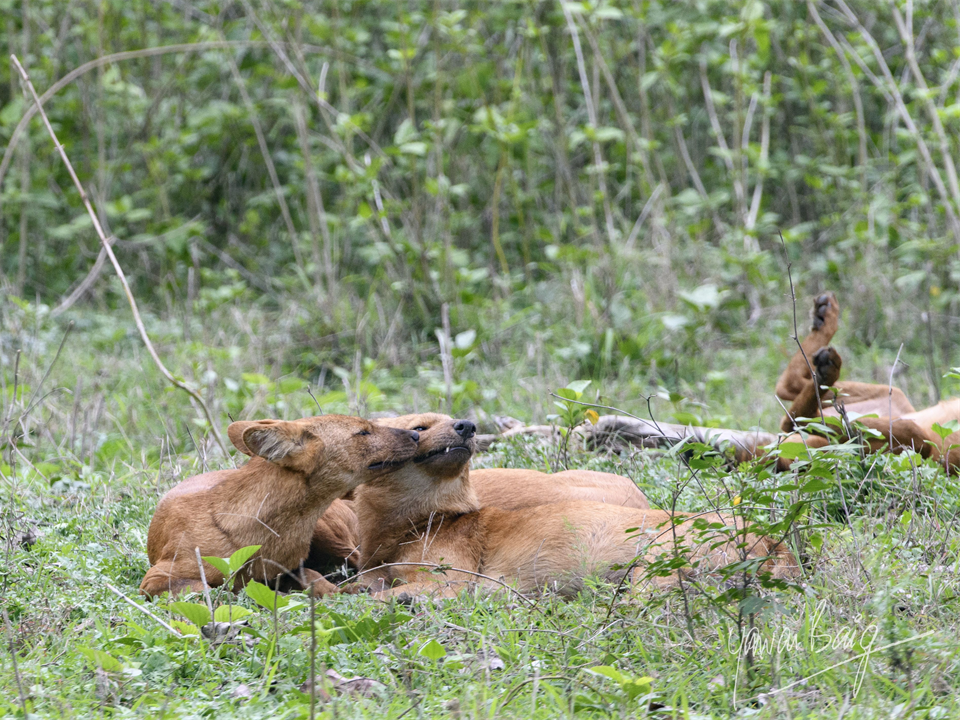
Another encounter you could have is with wild dogs, the dreaded Dhole. This is a very attractive looking animal with an orange colored coat and a black bushy tail. The Dhole can’t bark and makes a whistling sound instead. In one case someone sent me a video on YouTube with a Dhole calling in a way that is almost like the howl of a wolf. It is the only time I saw that. And that was because there was a tiger near her. Why she didn’t just run away, I don’t know. Maybe her den was nearby, and she may have had puppies in it and was calling the pack for help. Dhole, like wolves, jackals, Painted dogs of Africa and coyote in the Americas, are family animals, like all dogs in their natural habitat with highly developed social order. They support one another, feed each other’s pups, regurgitate meat from their kills for their pups and take care of each other. I have seen young dogs take meat out from the mouth of older, unrelated dogs. The older dogs just let it go without attacking the young dog or protesting in any way. That is so different from our domestic dogs, who fight tooth and nail over a bone. Maybe it is human company that does this to dogs; makes them fight instead of sharing.
One day I got news of a Dhole kill in my Candura Division. The same place where I’d had the encounter with the elephants very early on in my career. Dholes kill by teamwork. Individually, the dog is too weak to kill anything but small game. Their usual prey however, is Sambar deer. A full-grown Sambar is the size of a large horse and on its own can easily kill a Dhole. However, the dogs select either a weak or sick animal or even more often a pregnant female, which is heavy with its baby and can’t run too well. Then they chase it in a relay. The dogs take turns and rest but make sure that the Sambar is running all the time. Combined with the terror that the Dhole strikes in the heart of the animal it does not take too long to run the animal to a standstill. Then they close in for the kill and hamstring the animal. They also simultaneously go for the soft under belly, the udders and the throat. The kill is not neat, not fast, and not clean. Eventually the animal dies of blood loss while the Dhole feeds on the living flesh.
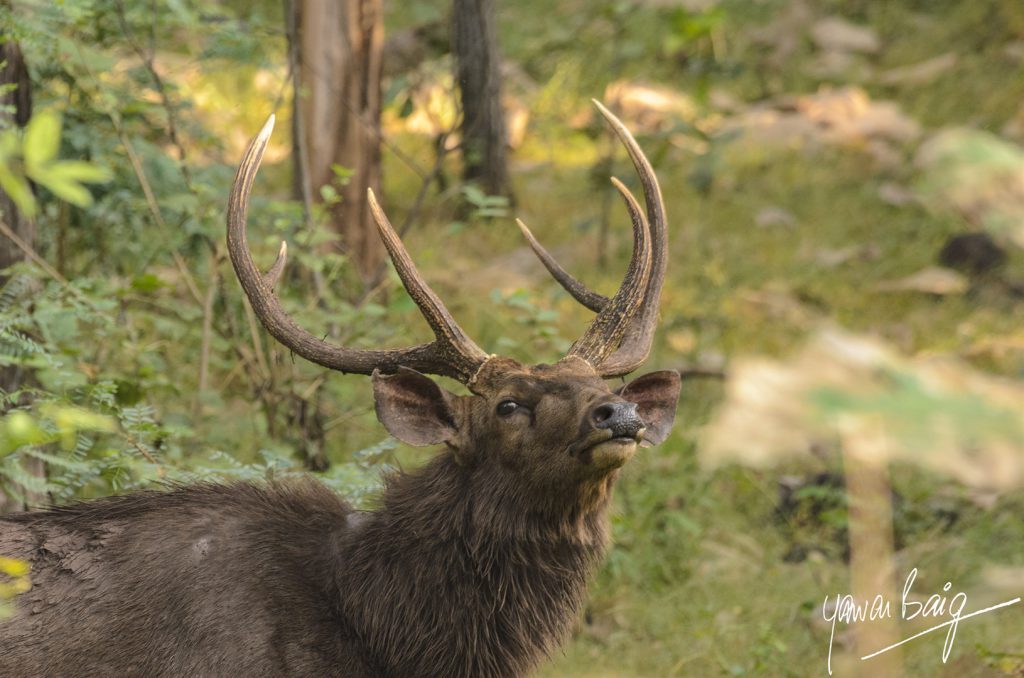
When I reached the place where they had taken down a Sambar doe, I saw that the doe had been killed in a valley just below the labor quarters. There was a large flat rock on which the animal was lying. Mercifully she seemed to have died by the time I got there. The dogs were all over the carcass, making excited little whistles and tearing at the flesh and swallowing it without chewing. Later the bitches would regurgitate the semi-digested meat for their puppies in the dens. Dholes don’t attack humans and so I walked down to where the carcass was lying. Not a pretty sight at all. I just went to make sure that the poor animal was dead with the intention that I would put it out of its misery in case it was alive. As I approached them the Dhole looked at me. The tone of their whistles changed, and they all moved reluctantly away and sat all around the rock in a circle. Having made sure that the Sambar doe had died, I did not want to test the theory that Dhole don’t attack humans, so I left them to their meal. As I walked away, I reflected how easy it was to apply our human values to incidents like this and to imagine that some animals are ‘cruel’ and some are not. The reality is that the animal kills only to eat. Never in revenge. Never to hurt. Never to wipe out another species. Never because it wants to dominate another. The reality in my view is that if humans applied these so-called animal values, we would live far more peaceful lives than we seem to do with all our sophisticated civilization.
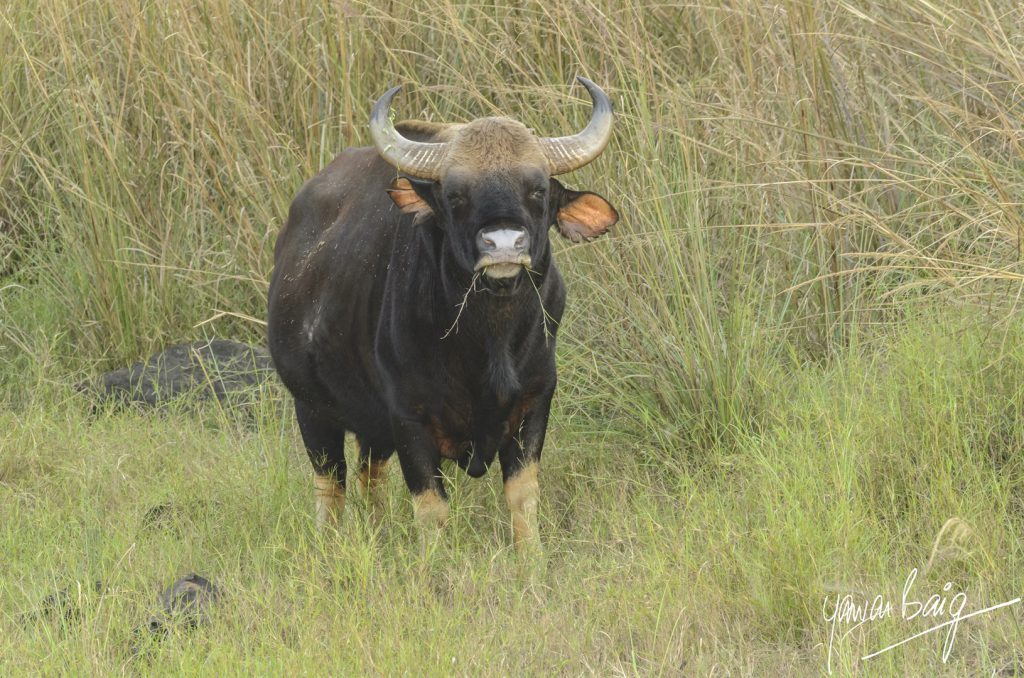
The Anamallais are also home to the Gaur (Indian Bison). Since they have plenty to eat in the rain forests of the Anamallais, they grow to huge sizes. As they live in thick forests, their horn span is not too wide, but the animals themselves grow to enormous sizes. There was one particular bull that lived in the coffee estate that Tata Tea owned, about halfway between Sheikalmudi and Valparai. He had been named Tyson by some rather unimaginative planter. We would almost always see him when we returned from the Anamallai Club late at night. He was totally harmless if you did not trouble him, as are all Gaur, but he was huge. Easily standing over six feet high at the shoulder and weighing probably in excess of two-thousand kilograms with the signature white socks on his massive legs, he was a magnificent animal. He was probably an old bull because he was always alone and had probably been driven away from the herd. If that was the case, I would have liked to see the one that drove this one away. For all their size Gaur are amazingly agile. This bull would clear the 6-foot-tall barbed wire fence with the electric wire over the top in a single standing leap without even a run up. You can imagine the power in those hind legs which could make two tons of body airborne.
In Lower Sheikalmudi we had a coffee area which was adjacent to the reserve forest. The coffee presented open grazing area to the Sambar and Gaur that lived in the reserve forest. They did not damage the coffee itself but would feed on the grass and shrubs that grew in the fields. I set up two or three salt licks in this area to attract these animals and to get them used to coming into our area so that we could watch and photograph them. For this I got some bricks of rock salt from the Forest Department and cleared small patches in the grass to arrange them. Once the animals discovered them, we would have a huge herd of Gaur, about thirty-five of them, who took up residence in the coffee area. They would come down from the hills every evening as the sun went down and would leave only the next morning once our workers started to arrive in the fields. They would be joined by several Sambar hinds and stags so that when I would drive into the coffee area at night, I would see this big herd lying down and chewing the cud. It was almost like seeing domestic cattle at rest; the Gaur had become so used to us. Grazing animals love salt, which they get from deposits in the soil. Carnivores get it from the blood of their prey. So, if you put out some salt in the forest you are sure to get anything which was in the vicinity to come visit.
If you walked to the end of the coffee area and entered the forest, taking the small pathway leading up the hill, you would pass under the heavy shade of big leaved, tall trees. Lining the path were lovely light green big leaved shrubs, which if you didn’t know what they were and took one in your hand, it would prove to be a very painful and potentially dangerous experience. These are stinging nettles called locally Anaymarti (the chaser away of elephants). The leaves have poisonous hair on them, which produce anything from painful rashes, to blisters, to high fever, and delirium, depending on your level of tolerance. As you walk along this path it is a good idea to keep all your senses functioning. The thick undergrowth can and does hide anything. As you continue climbing steadily, getting sweatier by the minute due to a lack of breeze, you come to a small flat rock on your right a little way inside the forest. If you walk silently you will almost always see the resident cobra that likes to sun himself on that rock. Sometimes you will see his skin, which he has shed and then you must be very careful because he is almost blind for a while and extremely irritable.
As you continue onwards, you will come out of the forest into an open area which is a sheet of rock. This area stretches about a kilometer or more, all the way up to the ridge beyond which the forest descends three-thousand feet down to the backwaters of Parambikulam Lake. This sheet of rock is covered with a patchy lichen growth almost all over which becomes yellow when it matures and so it is called Manjaparai (Yellow Rock). This is also where you get the first breath of cool breeze, most welcome on your hot and damp brow. There is a large clump of thorny bush right before you and almost surely you will hear the ‘Dhank’ of a Sambar doe as she bolts out of the bush and gallops down the thirty degree rocky slope at a speed that would certainly kill a horse in a second.
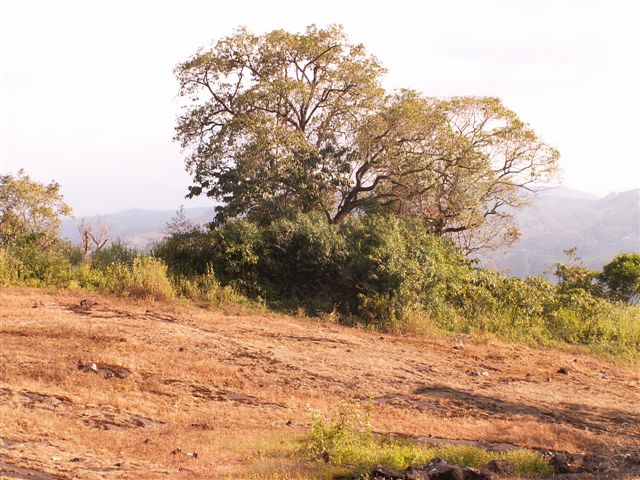
If you continue to climb then you would eventually come to the top of Manjaparai, which was a small flat plateau through which flows a small perennial stream. I’d had a machan (platform) built on a tree at the edge of the forest overlooking the stream, which empties into a small pool and then goes down the slope of Manjaparai. I had cleared a small pathway to get to the machan tree, but without disturbing the area or its animals. The machan was halfway up the tree at a height of about twenty feet. It was quite substantial and could comfortably seat four people. We would sit there late into the night watching animals come to drink at the pool. It was an amazing experience to suddenly see a shadow move and realize that what you had been looking at was not a shadow at all but a Gaur bull; the herd leader who was watching to see if the coast was clear to signal his herd to follow him to the water. This forest has tigers and so the Gaur and Sambar, which are its main prey are very cautious.
We once had a full-grown Gaur cow killed by a tiger in our coffee area. At first the Forest Guards came and tried to accuse me of having shot the animal in an attempt to extract some silence money. But I would have none of that and demanded that the DFO come to inspect. When he came, I took him to the carcass and showed him the telltale claw marks of the tiger. The tiger attacks from behind and rides the animal, and as it gallops in panic, the tiger reaches forward and hooks its claws into the animal’s nose and draws its head back, biting into the back of the neck to get at the spinal cord until the animal falls and breaks its neck. If you see the neck of a Gaur, how thick and muscular it is, you can imagine the strength of the tiger which can force that neck to bend back until it makes the animal fall. Tigers generally go for juveniles or cows, which are smaller. The big bulls are immune to everything except men and old age. The DFO (District Forest Officer) was more knowledgeable than the Forest Guard and so the matter was resolved.
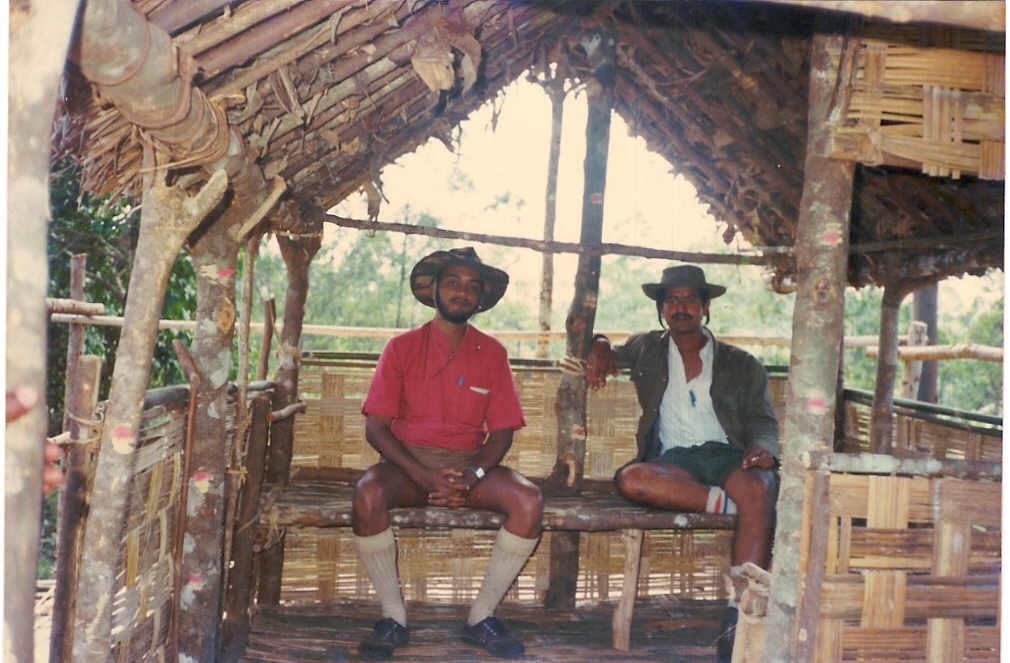
You sat in the machan very still, secure in the knowledge that you were invisible unless you moved. Though the game viewing was amazing, the stillness made you very stiff, a relatively small price to pay for the privilege of watching wild animals in their habitat. In the early hours of the morning, after all animal movement had ceased and it started getting bitterly cold, which it does in the forest at that elevation, we would come down onto the rock, light a nice big fire and warm ourselves and spend the rest of the night sleeping on the rock around the fire. Then in the morning we would re-kindle the fire and put on the tea pot and watch the sun come up over the horizon. I know many people lived in Lower Sheikalmudi, but I don’t know of anyone other than myself and Suresh Menon, who was my assistant at the time, who enjoyed the beauty of the forest like we did. It was a rare privilege and we appreciated every minute of it.

Please log in to leave a comment
Loading comments...

I have formulated 6 rules which I call David’s rules. These are for anyone facing the big one ...

One of my friends who comes from ...
I have said this a million times, if I have said it once – the three crimes committed on society with society’s blessing are: Commerci...